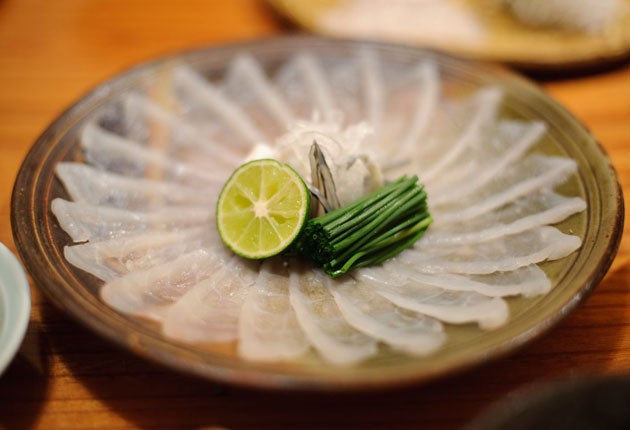The first rule about fugu supper club: you don't talk about fugu supper club. The second rule about fugu supper club: you don't eat any of the organs – especially the liver, or the skin.
A new dining experience, bringing Japan's most notorious and deadliest fish delicacy, the tiger blowfish, to the UK launches at the end of this month.
The torafugu is one of the most toxic marine creatures, it is extremely difficult to safely prepare, and consequently among the priciest dishes on Japanese restaurant menus.
The delicacy is not permitted for sale in the European Union, but a new venture, Fugu Supper Club, aims to circumvent the rules by serving it to private diners, who can register their interest on its website. They will subsequently be informed by email of the time and location of their sitting. Two chefs are involved in the venture but, at least until the first supper club meeting at the end of this month, their identity remains a secret.
In Japan only licensed chefs are permitted to prepare fugu. The examinations and practical tests required take two years to pass at the basic level.
The Fugu Supper Club chefs are, diners are assured, fully qualified. Those who sign up will find out their identity, but for the moment, no one else. The Supper Club meetings will take place in as yet undisclosed London locations, ranging from a grand mansion to an unoccupied gallery space. Those who attend can expect a champagne reception and six courses, most of which will feature the iconic ingredient, as well as wine, sake, Japanese beer and Japanese whiskey, for a club "donation" of £250.
The price tag is far from the most frightening aspect. Fugu can be lethally poisonous due to its tetrodotoxin. One fish contains enough poison to kill 30 adults, and it has to be carefully prepared to remove toxic parts of the anatomy and to avoid contaminating edible flesh. So is it worth the risk? As with all delicacies, fugu is said to be something of an acquired taste; rather subtle, and when prepared by the finest chef, leaves a tingling sensation – remnants of the toxins that make it so dangerous.
Your chances of survival, from a fugu meal, are reassuringly high. Between 1996 and 2006 the Tokyo Bureau of Public Health recorded between 20 and 44 incidents of fugu poisoning every year, with an average fatality rate of 7 per cent. The vast majority of these involved fishermen eating their catch. Only one occurred in a restaurant.
Organisers hope the event will remain reasonably low key. It could blow up and be something really huge, said a spokesman, with no hint of irony. What if there are problems with shipping, problems with regulations, and so on? Or what if someone got poisoned? "We're proceeding with caution for the moment," said the spokesman. "We have undertaken a lot of research over how we can bring it in to the EU. There are many laws and regulations that are in place in Japan before they can be exported. If the names of the chefs involved become public, people will be able to work out how we have done it."
For many Westerners, fugu is most closely associated with an episode of The Simpsons in which Homer eats an ill-prepared fish and is led to believe he has 24 hours to live. But it turns out to be a false alarm and, vowing from now on, to live life to its fullest, by the end, he is back on the sofa watching bowling and eating a large bag of pork scratchings. It could be you.
A delicate operation
* It takes between seven and 10 years of study for a fugu chef to attain the experience needed to prepare the dish for the consumption of the general public. In Japan, a fugu chef is bound by law to taste every dish he serves.
* The most precise knifework is required to remove the poison tetrodotoxin contained in 11 parts of the fish, including the skeleton, liver, ovaries and intestine.
* A fugu chef will begin cutting the fish while it is still alive, and the most skilful will serve it while the meat is still wriggling.
* The most popular fugu dish is sashimi, for which the chef slices the fish so thinly that the plate can be seen through it. The fish is often arranged and served to diners in the shape of a chrysanthemum – the flower of death in Japanese culture.
* The best fugu chefs can fillet the fish in such a way that a safe amount of poison remains in the meat to create a mild euphoria.

Join our commenting forum
Join thought-provoking conversations, follow other Independent readers and see their replies
Comments